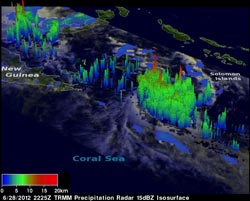TRMM Sees Post-Season South Pacific Tropical Cyclone 21P

NASA's TRMM satellite 3-D image showed that some of the storms around Tropical Depression reached heights of at least 15km (~9.3 miles).<br>Credit: SSAI/NASA, Hal Pierce <br>
TRMM is the Tropical Rainfall Measuring Mission satellite that is managed by NASA and the Japanese Space Agency, JAXA.
The center of Tropical Depression 21P was directly beneath the TRMM satellite when it passed over on June 28, 2012 at 2225 UTC (~8:25 a.m. local time). A rainfall analysis using data from TRMM's Microwave Imager (TMI) and Precipitation Radar (PR) instruments showed that the tropical cyclone, although small, was well organized and contained some intense convective storms dropping rainfall at a rate of over 50mm/hr (~2 inches).
At NASA's Goddard Space Flight Center in Greenbelt, Md., Hal Pierce of the NASA TRMM Team created a 3-D view of Tropical Cyclone 21P using TRMM's Precipitation Radar data. The 3-D image showed that some of the storms around the tropical cyclone were reaching heights of at least 15km (~9.3 miles).
Tropical Depression 21P didn't reach tropical storm force, however, and faded in the Coral Sea over the past weekend (June 30-July 1) due to adverse atmospheric conditions.
Text Credit: Hal Pierce
SSAI / NASA Goddard Space Flight Center, Greenbelt, Md.
Media Contact
All latest news from the category: Earth Sciences
Earth Sciences (also referred to as Geosciences), which deals with basic issues surrounding our planet, plays a vital role in the area of energy and raw materials supply.
Earth Sciences comprises subjects such as geology, geography, geological informatics, paleontology, mineralogy, petrography, crystallography, geophysics, geodesy, glaciology, cartography, photogrammetry, meteorology and seismology, early-warning systems, earthquake research and polar research.
Newest articles

Superradiant atoms could push the boundaries of how precisely time can be measured
Superradiant atoms can help us measure time more precisely than ever. In a new study, researchers from the University of Copenhagen present a new method for measuring the time interval,…

Ion thermoelectric conversion devices for near room temperature
The electrode sheet of the thermoelectric device consists of ionic hydrogel, which is sandwiched between the electrodes to form, and the Prussian blue on the electrode undergoes a redox reaction…

Zap Energy achieves 37-million-degree temperatures in a compact device
New publication reports record electron temperatures for a small-scale, sheared-flow-stabilized Z-pinch fusion device. In the nine decades since humans first produced fusion reactions, only a few fusion technologies have demonstrated…





















